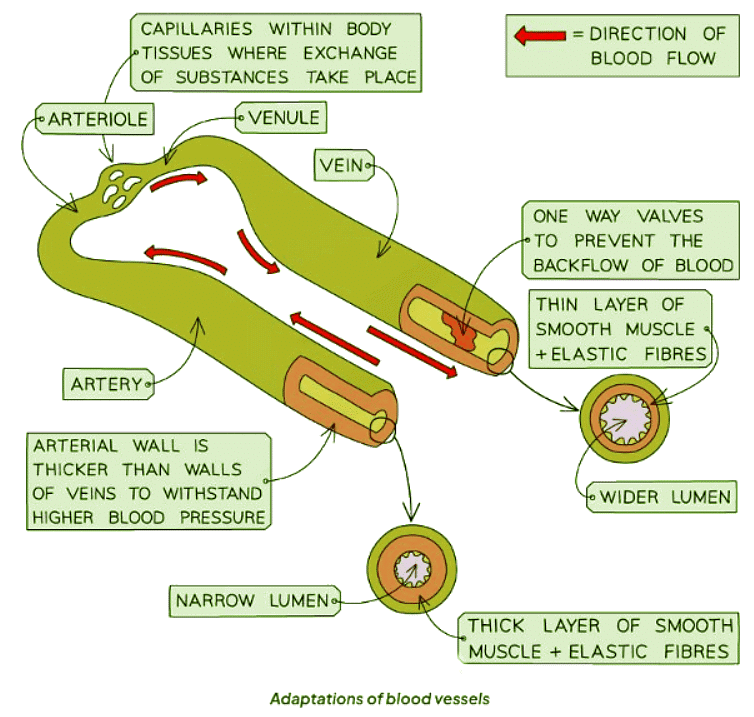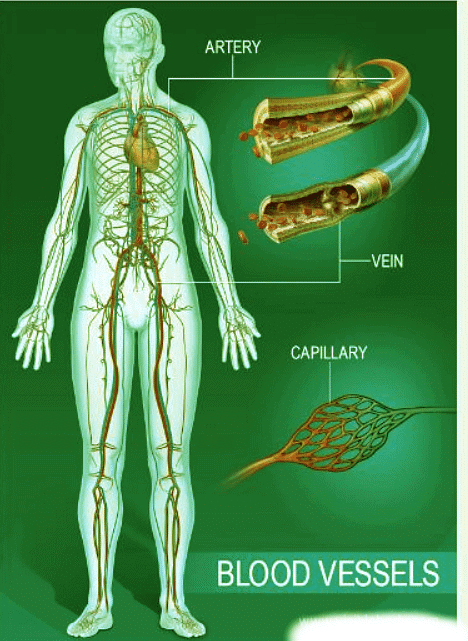Class 10 Exam > Class 10 Notes > Biology for GCSE/IGCSE > Structure & Function of Blood Vessels
Structure & Function of Blood Vessels | Biology for GCSE/IGCSE - Class 10 PDF Download
How Structure of Blood Vessels is Adapted to their Function: Extended
Arteries
- Arteries possess thick muscular walls embedded with elastic fibers, enabling them to endure the substantial pressure exerted by blood flow and sustain blood pressure by recoiling after blood passage.
- They feature a relatively narrow lumen to uphold elevated pressure levels within the vessel.
Veins
- Veins are characterized by a spacious lumen, a design suited to accommodate the lower pressure of blood flow within them.
- They incorporate valves, crucial for impeding the reverse flow of blood, especially given the reduced pressure within veins.
Capillaries
- Possess walls that are exceptionally thin, typically just a single cell layer thick, facilitating the efficient diffusion of substances across them.
- Feature permeable walls, allowing for the controlled leakage of blood plasma, thereby enabling the formation of tissue fluid surrounding cells.

Arterioles and venules
- Arteries progressively narrow as they branch out from the heart, with the smaller vessels connecting arteries to capillaries known as arterioles.
- Similarly, veins undergo narrowing as they extend away from the heart.
- The slender conduits linking capillaries to veins are termed venules.

Question for Structure & Function of Blood VesselsTry yourself: What is the function of valves in veins?View Solution
The document Structure & Function of Blood Vessels | Biology for GCSE/IGCSE - Class 10 is a part of the Class 10 Course Biology for GCSE/IGCSE.
All you need of Class 10 at this link: Class 10
|
101 videos|193 docs|33 tests
|
FAQs on Structure & Function of Blood Vessels - Biology for GCSE/IGCSE - Class 10
| 1. How are blood vessels structured to carry out their functions efficiently? |  |
Ans. Blood vessels are structured with three main layers - the tunica intima, tunica media, and tunica externa. This structure allows for the efficient transport of blood, as well as providing support and flexibility.
| 2. What is the function of the tunica media in blood vessels? |  |
Ans. The tunica media is responsible for regulating the diameter of the blood vessels, which in turn controls blood flow and blood pressure. It is made up of smooth muscle cells and elastic fibers.
| 3. How do capillaries differ in structure from arteries and veins? |  |
Ans. Capillaries are the smallest blood vessels and have thin walls that allow for the exchange of substances between the blood and tissues. Arteries and veins have thicker walls and are responsible for transporting blood to and from the heart.
| 4. How do blood vessels adapt to changes in blood pressure? |  |
Ans. Blood vessels can constrict or dilate in response to changes in blood pressure to help regulate blood flow. This is achieved through the contraction or relaxation of the smooth muscle cells in the tunica media.
| 5. What role do valves play in the function of veins? |  |
Ans. Valves in veins prevent the backflow of blood and help maintain the one-way flow towards the heart. This is particularly important in the lower extremities where gravity can cause blood to pool and lead to issues like varicose veins.
Related Searches




















